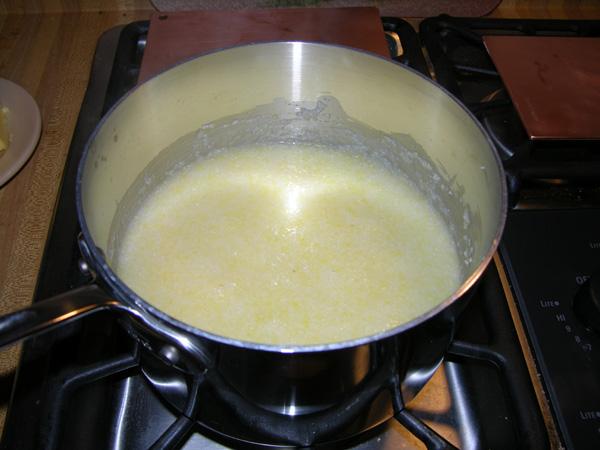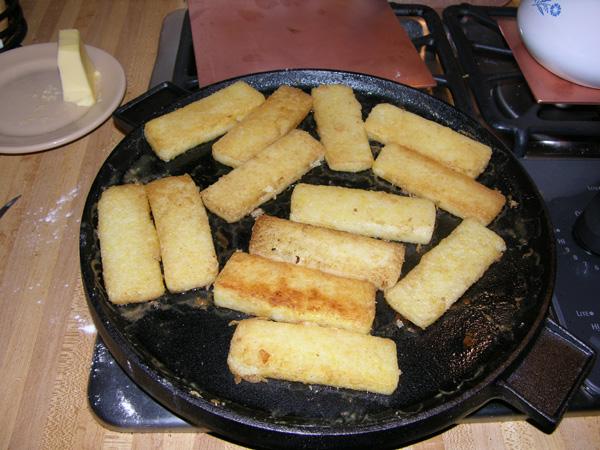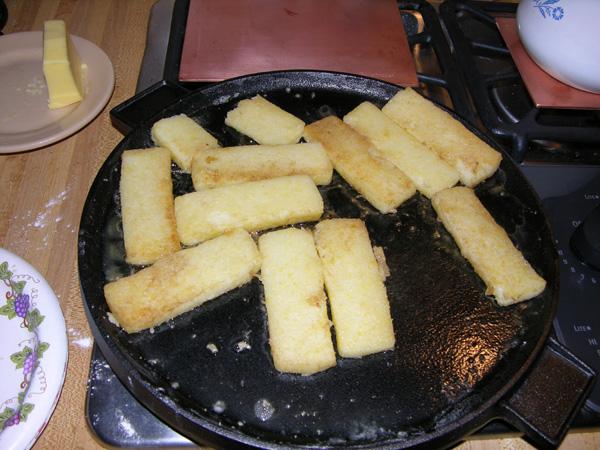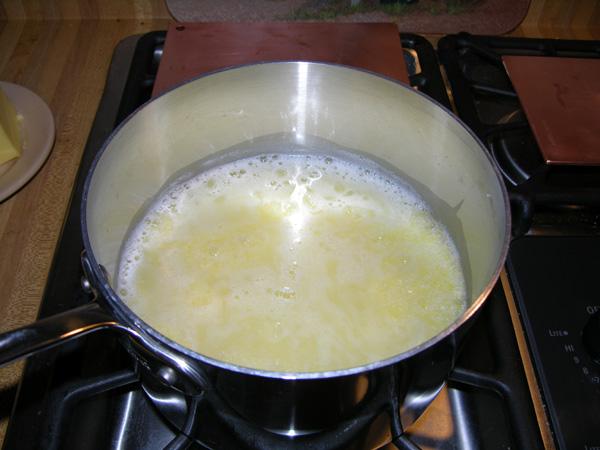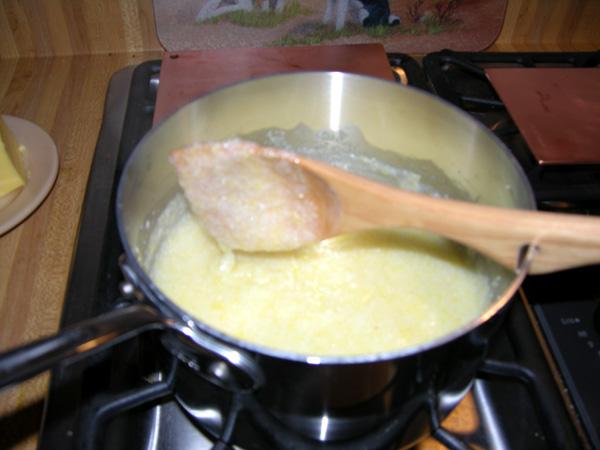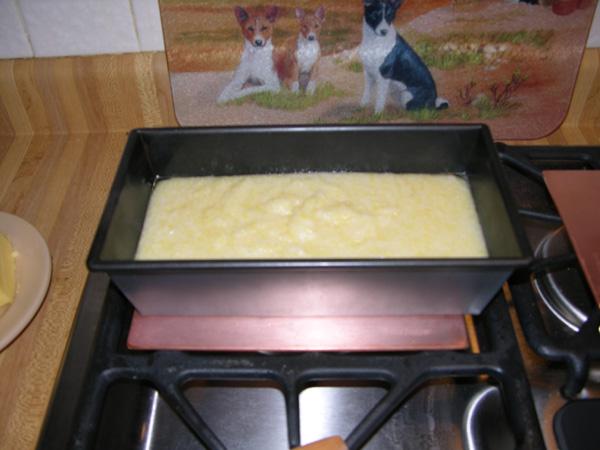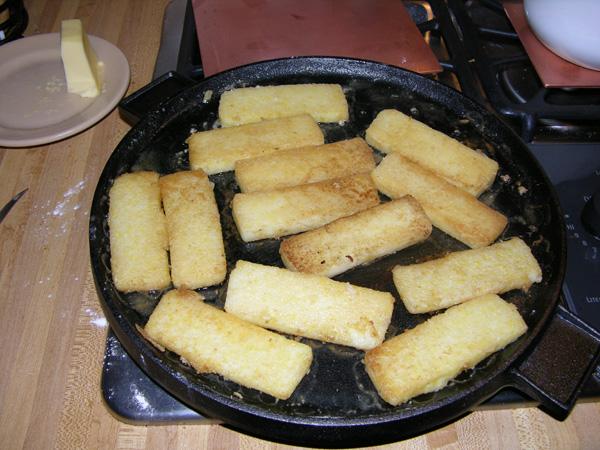-
Posts
11,033 -
Joined
-
Last visited
Content Type
Profiles
Forums
Store
Help Articles
Everything posted by andiesenji
-
Here's a "tutorial" I did a while back on "fried grits" (aka polenta). You need a griddle that can get to high heat - non-stick pans just do not produce the best results. I have fried them on my Cuisinart griddler with good results but they do best on a well-seasoned cast iron griddle - or a good heavy aluminum griddle. I use a combination of butter and oil - grapeseed oil preferred because of its higher smoke point, it actually keeps the butter from burning. However, I have also used Crisco with very good results. Do not use olive oil. Grits, white and yellow, freshly ground, stirred into boiling water. at 20 minutes they have absorbed a lot of water: at 40 minutes they are done: Poured into a loaf pan to cool overnight: This morning, sliced, lightly dredged with flour and into browned butter on the griddle: If you use rice flour the outside will be crispier. nearly done: Finished, ready to plate and eat with eggs, bacon and/or sausage and maple syrup or ?? Very tasty!
-
When I baked them, there was no Pam on the tots themselves. I did use Pam just on the foil lining the cookie sheet so they wouldn't stick. As I said in my original post, where they made contact with the foil-covered cookie sheet, they blackened instead of crisping due to the cookie sheet being a dark brown metallic pan.The sheet overrode any crisping effect the Pam on the foil could have had (I should have used an air-cushioned cookie sheet). I may try a split experiment the next time. Half the package on a cookie sheet, spraying the tots with Pam, and the other half fried in a skillet. We'll figure this out yet! I baked them on a wire grid over a sheet pan with much better results than directly on the sheet pan. They did not get super crispy but they were more crisp than with the basic instructions. They did take longer even in the convection oven - almost 40 minutes, however ovens vary so much that you have to check them during the last 10-15 minutes.
-
Earlier in this thread I mentioned gurkensalat. And there is always Julia Child's Braised cucumbers...
-
I use the Pro-Pest traps, also from Amazon. They last longer - they say 60 days but I change them out every 3 months and have excellent results. The Catchmaster traps were not as effective at attracting the moths as I would see them fly right past the trap.
-

Frais de Bois Along the CA Coast & Thank You
andiesenji replied to a topic in California: Cooking & Baking
The Santa Barbara certified Farmers market schedule gives you several choices for days to shop. The last time I shopped at the one in Montecito they had alpine strawberries, white raspberries and currants, including black currants. There was also one stand that had an exceptional offering of herb plants. -
You do need calcium chloride for pasteurized milk - actually the ultra-homogenized stuff - because otherwise curds will not be firm and your results will be a grainy mix which is unsuitable for making cheese. I've been making my own cream cheese, chevre, and other fresh cheeses for decades and also made some aged cheeses in the past but no longer. At my age it is easier to order the good stuff. I sold my big cheese press with which I could press several small cheeses or one large cheese so I no longer have the equipment for pressing them.
-
And you might also get the servers who miss the "good ol' days" when they often went home with several hundred dollars cash in their pockets. This issue simply is not so obvious as some would believe. There definitely are a great many servers that like the system just fine as it is. You can't go raising prices up by 20% without some kind of justification, or no one--customers, employers, and employees won't buy into it. You need a system of benchmarks and qualifications to justify and keep the 20% mark-up specifically for service labour costs, and they (benchmarks) have to be on a graduating scale. For instance, it would be a very tough sell for a lunch (or breakfast) place that specializes in the $10-$20.00 bill/check per person to add a 20% increase for service. And you can forget about fast-food burger joints. The server does not need extensive--if any, wine/liquor knowledge, formal place setting knowledge, or extensive cooking and ingredient knowledge, as compared toa fine dining place. As I've stated before in this thread and others, you need a graduated set of benchmarks for servers, I.e. Server I qualification with no previous experience, Server II that requries X hours of previous experience and a basic wine/liquor knowledge, and Server III qualification, that builds on the last two qualifications and would probably be a pre-requisite for a Maitre D' position. But hey, all this would be trade infrastructure, and the N. American Hospitality biz is notoriously bad for not having any trade infrastructure. If anyone can call themselves a Chef, if any school can call it's gradutes "chefs", then what's the criteria for a server? I missed this when it was first posted. Restaurants OFTEN use excuses for raising their prices and it has NOTHING to do with how much they pay their personnel. Prices at some "upscale" chain restaurants vary with location and by state. A local restaurant upped their prices when they installed two new big screen TVs, for "sports" programs, even though more than half their clientele filled out "suggestion" cards that indicated they were interested in having a peaceful MEAL, not having to listen to sports fanatics yelling because of what was happening in the game. They lost a significant amount of business and now there is ONE TV in the Bar/lounge and none in the two dining rooms. Some of their customers have returned but others found other places and are satisfied. They also lost banquet business because one of the TVs was mounted on a common wall with the banquet room. Really, really stupid idea...
-

Yard Sale, Thrift Store, Junk Heap Shopping (Part 2)
andiesenji replied to a topic in Kitchen Consumer
Looks like a regular 120 3-prong plug. I have a "vintage" one made in 1947 and it operates on 120 and has only a two-prong plug... -

Yard Sale, Thrift Store, Junk Heap Shopping (Part 2)
andiesenji replied to a topic in Kitchen Consumer
That's adorable. Nifty find! -
The title "It's Only Slow Food Until You Try to Eat It" does not really give one an idea of what this book is really about. The subtitle: "Misadventures of a Suburban Hunter Gatherer" is much more descriptive of the contents. First of all, it's got a lot of very funny writing. And there are some real "characters" that the author describes so well that I felt I could shake hands with them. I highly recommend this book for anyone who really loves food and wonders why we eat what we eat and what happened to the things that once were common on the tables of America - or for that matter, other countries where it is difficult to find anything but "factory food" unless one lives in a truly rural area. Here is the review I wrote for Amazon. I received the book via the Amazon Vine program so am required to publish a review but this is one I would have reviewed anyway. Funny, enthusiastic, witty and insightful. This is really a remarkable book because it looks at things that we see every day in a different light - that is, consider how many times you may walk past something that in the past was a source of food for many of our ancestors. And not just Native Americans but ordinary folks like me and you. I grew up on a farm in the 1940s when most of the people in the area still gathered wild "greens" in the spring, pawpaws, maypops, berries, wild asparagus, onion grass, ramps, plantain, watercress, mallow, nasturtiums, nettles and purslane as well as the wild mushrooms that only the experts in the family were allowed to pick. There was also hunting and fishing, finding bee trees (for the local "bee charmer" to harvest). The author writes with wonderful humor and modesty in that what he was doing is often labor intensive but certainly for one who truly believes in eating what is available for free (and often tastier than anything in the stores) it is worthwhile, totally satisfying. He writes about his backyard garden and reading his description of a homegrown tomato and the incredible flavor, causes me to wish that I had managed to find the effort to plant some this year. I am growing herbs, onions, shallots and radishes but thats it for this year. His description of his adventures in Cajun country had me laughing out loud and the writing makes the scenes so vivid that it is easy for me to picture exactly what was happening. We hunted frogs when I was a child but we used long-handled fish nets because my grandpa was afraid we would stab each other (or ourselves) if we had gigs. The rule was, if you caught it, you cleaned it once one was old enough to handle a knife safely. His trip to Alaska to spend some time with the Native Gwich'in people of the Alaskan tundra is equally inspiring. It also points up the problems these people are having with the attempts of the oil companies to exploit an area that is CRITICAL to the continuing success of the caribou as the ANWR area is their calving ground and not even the natives go there because it is important to not disturb the routine that has been going on for hundreds of thousands of years, or longer. Foraging around San Francisco can be successful but the writer indicates that some people appear to be in it only for the notoriety (or the money) and not from any personal conviction about sustainability. The local expert who takes him on a seafood excursion is at the other end of the spectrum, doing it for the sheer pleasure of finding something that other people do not even realize is there. And, it is also a love story... I recommend this book to anyone who likes to read about urban ADVENTURES that anyone can have if they take the time to look around and actually SEE what is there if one just bothers to take some extra time. I wish that I was still physically capable of doing some of these things but age and arthritis forbid it. Meanwhile I can enjoy the experiences of writers like Bill Heavey vicariously through his evocative writing.
-
Sorry Martin. I did not realize you are in Denmark, as there is no locality identifier under the avatar as we had in earlier versions. I have some friends in Sweden who are going to be visiting here in So.Cal in July and will see if I can work something out with them. One works for the airline so is able to sometimes transport things (usually dogs) at a discount. I'm sure sending a "gift" from Sweden to Denmark wouldn't be difficult or too expensive. I've sent an item to Iceland a few years ago and it worked out nicely. Will keep in touch - I bought the grinder. The only other suggestion - after the steaming and roasting - would be to break them up in a mortar and pestle and then finish them in the food processor. I used to use this method to get the process started on macadamia nuts.
-
Try steaming the hazelnuts rather than boiling them directly in water. Steam them first for about 10-15 minutes and then spread them on a sheet pan in the oven - 275° F. for about 20 - 30 minutes. I've also used this method with Brazil nuts which also tend to be a bit grainy. I would recommend you buy a food grinder like this one that INCLUDES the NUT BUTTER blade - (the one on the left next to the card). Sometimes the old ways really work.
-
I'll be interested in the results. I wouldn't use margarine anyway - only butter in my cakes.
-
That sounds like too many eggs to me. I have several recipes - the one I use most calls for 200g self-rising whole meal flour and uses 3 eggs/150ml. Here's the recipe - it makes the best carrot cake I have ever made and I have tried numerous recipes over the past FORTY years since I first came across a recipe in a Pennsylvania Dutch cookbook.
-
The soy milk appliance does a better job at this particular task without the mess of having to strain out the pulp - and I like the smoothness or creaminess of the end product. I've also used to to make soups - I have a little cookbook (that at present is hiding) that has some interesting recipes for various ways to use it. The Thermomix has its uses but there are some things that other appliances do better - I have never been able to successfully beat egg whites to the consistency I want in it, no matter how well I clean it, etc. I use my stand mixer. I use dry unsweetened coconut - the local Asian markets carry it in bulk and have a rapid turnover so it is always fresh (and cheap). In that also I make a batch, remove the solids, add "fresh" coconut (that I have soaked) and run through the process again and sometimes repeat it to get a much richer result - more like coconut "cream" which I like to use in curry as the various spices seem to "bloom" and produce more flavor with the extra fat. When I first began making nut milks when I got my first Vita Mix, back in the late '60s, I relied on straining out the pulp. We also had a Champion juicer and I tried using that but while it did strain out the pulp, it did not extract enough of the oils to make a rich "milk" at least to my satisfaction. So I have been experimenting with this process for more than 4 decades and was more or less satisfied with the results with the various machines but I am really thrilled with the Soyabella. I do love appliances but they really have to WORK to get top marks from me.
-

Yard Sale, Thrift Store, Junk Heap Shopping (Part 2)
andiesenji replied to a topic in Kitchen Consumer
Yes. He was quite the find, too, although not at a yard sale. I got lucky that he likes yard sales and thrift shops, too. Most recently, he forwarded me an e-mail that he got telling him about an estate sale pre-sale, which contained an ad for a Bernina 930 with cabinet. He knows I like Berninas, and my 830 needs motor work, so he told me about the sale. Long story short, I am now the proud new owner of a Bernina 930, with all the accessories, a wonderful sewing cabinet, and a bunch of thread that came with it. I also bought a little box of silk mending thread on little wooden spools made by Belding Corticelli. Apparently, they shut down in the '30's. I didn't realize it was silk until I got home and looked more carefully. I was mostly interested in the box and spools to make a mending kit for my travel bag, but I changed my mind about that, upon discovering the thread is silk. As much as he can drive me nuts, and vice-versa, he is a wonderful guy. That's an impressive find. The finest silk thread by Belding Corticelli was often used to repair silk stockings. I have some TINY latch hooks that were made for repairing runs in silk stockings, which were often colored in every shade. My grandmother had them in pastel colors for spring and summer and darker colors for winter. (The fashion for "neutral-colored" stockings began about 1938.) One of my great aunts worked for Belding Brothers and today's employers should take a page from their book. They wanted INTELLIGENT young women and paid them well and build nice, safe and modern (for the time) buildings to house them. When I was a child my great grandmother still had a stash of Belding, Hemmingway, Corticelli silk embroidery floss that she had been hoarding since the company stopped production in 1932. The colors were much brighter and stable (non fading) compared to other brands. It's a treasure. -
I'd be concerned about putting a baking sheet under a bundt pan. Some recipes need to be baked in a pan with a hole so that warm air flows through the hole, thus helping to cook the cake both from the outside of the pan AND from the hole. If you put a baking sheet under the bundt, you destroy that airflow and it adversely affects the baking of the cake. Professional bakeries put the pans on sheet pans all the time. In a lot of commercial bakery type ovens, there are no shelves at all, just slots for sheet pans to become the shelves. In larger ones, you can just roll a speed rack, or four, or more, into the oven, hook it up and leave it to bake -once again everything is on a sheet pan. Correct. The metal sheet pans heat up and the "convection" of heat radiates upward, including through the hole in the center of the pans. In my mom's bakery we had a big "revolving tray" oven in which the "trays" were as thick as boiler plate and transferred a lot of heat. We baked directly on them, slid sheet pans loaded with product, with pans, sometimes with water bath pans (for cheesecakes) and etc. I've seen (and used) plenty of foil ANGEL FOOD pans but have never seen a "Bundt" pan (the name is copyrighted and licensed) and they work just fine with sponge type cakes but they will deform with very heavy, moist cake batters that expand and push outward as they bake. When I use them for fruit cakes that are going to be gifted in the pans, I double them, one inside the other for more resistance. Using just one, I have had some odd shapes emerge from the oven.
-
I used the same process as Franci for years - blanched almonds soaked overnight with a little salt, rinse and blend with water, usually a quart of water (I use warm) to two cups of whole nuts. If I wanted it for drinking, or for cereal, etc., I strained it using a jelly bag. About 5 years ago I got one of these not particularly for soy milk but for nut milks, rice milk and especially almond milk. I have experimented with various processes to get a special effect. I make a batch of the almond milk and remove the pulp (which I spread on a sheet pan and dry in the oven to use as almond "flour" - also works with hazelnuts & etc.) I add more soaked, blanched almonds to the cup and process again - usually 3 times - to get a richer, thicker product (like cream) which I have used to make a yogurt-like and/or a cream cheese-like result. This also works beautifully in cooked custards, pies & etc., something that I never perfected making the almond milk in the blender. I also use it to make coconut milk and the result is much better than the canned stuff - is similar to the fresh-frozen which is quite expensive at the local Asian markets. The price has come down quite a bit since I bought mine. I saw it at Costco a few months ago for less than $100. $89.00 comes to mind. I have also used it to make soy milk but I order the non-GMO soybeans that are certified organic. I only make it when vegetarian friends, who prefer it to nut milk, are visiting.
-
The BEST Angel food tube pans have "feet" at the top edges of the pan because these cakes will collapse on themselves while cooling in the pan so they are cooled upside down. As are sponge cakes - such as orange chiffon, etc. Any cake leavened with beaten egg whites. Before a clever inventor add the feet, angel food pans were inverted over a bottle with the neck in the tube at the center (the way my grandmother's cook did it - using an old-fashioned quart beer bottle full of sand to resist tipping.) In my mom's bakery, we had a rack with several posts that had collars to support the tube pans - I don't remember when I first saw one with the feet but they were not easily found until the '70s.
-
Heavier cakes, with a high moisture content bake better in a Bundt pat because in regular pans the outside edges will cook much faster and the center will remain soggy. Ditto for sponge cakes, which is why they and angel food cakes are baked in tube pans. Flat sponge cakes are best when baked in shallow pans or sheet pans. In my mom's bakery, back in the 50s, we had weighted "cans" to put in the center of large round pans if we were baking the "traditional" fruited cakes because otherwise the center would never get fully cooked. As these were often tiered, it worked out fine because the center column for the upper tiers would go into the resulting hole. These were very heavy cakes, so needed the support. Here is an excellent explanation and history of the Bundt pan. I own several - including an original one I bought in 1960. I have one very large one (15 cups) and several smaller ones, various shapes and designs, all Nordic Ware. If you go to Amazon and put one in your shopping cart and leave it there, occasionally there are really good temporary price drops and you will get a notice that the item price has changed. A few months ago I got this one for $14.99, less than half the regular cost.
-

Yard Sale, Thrift Store, Junk Heap Shopping (Part 2)
andiesenji replied to a topic in Kitchen Consumer
Your set is from the late 1940s. One of my aunts had that same set and I remember it from about 1949. The mugs from the '50s and 60s were more tapered. The set included 12 mugs. The bowl and cups were first introduced in the 1930s - but the cups were different - shaped like teacups, rounded and the bowl was plain at first and then designs were added, floral and fruit - suggesting punch and then a Christmas design, for eggnog. You are lucky to have the base because it was often damaged from mishandling. When I was collecting, I would see many of the sets but only rarely a base. The drink was very popular in the late '40s - after the rationing and shortages during the war, people wanted to entertain with rich food and rich beverages - impossible during the war years. -
You don't have to fill it up to the top and you have to allow for some expansion. I measured mine, which is a "Turks-head" swirl and it is 1.5 qt. I have a taller, narrower one that is 1.7 qt I have four of the small 3-cup ones that I use for plum puddings - & etc. I got them from La Cuisine which is a favorite vendor because they carry some hard to find items.
-
This is the type of pudding mold Ben mentioned. Interesting that the black treacle that I have used is also listed on this page...
-
I dropped by Ben's place earlier this evening and we had a chat after the shop closed. He said the bakery "back home" had originally used stoneware "pudding basins" lined with cheesecloth (the fine butter muslin type) but as customers became more sophisticated and wanted something more attractive they opted to get the fluted pudding tins - which are usually used for Christmas plum puddings. He says "cans" per se were not used until fairly late in the 19th century because before that time LEAD solder was used and as it had a low melting point the cans would come apart with extended heating. Some can manufacturers continued to use lead solder into the 20th century. Bakeries that specialize in brown bread use shaped pans because they do not want to have their product look like the mass-produced canned stuff.
-
The bottom of the Foley has a wire "sweeper" which has been a feature on the Foley since it was first introduced in 1933. Anything that has been in production, with few changes, for 80 years WORKS. Here is a writer who give some history of the food mill.


